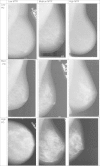Mammographic texture resemblance generalizes as an independent risk factor for breast cancer
- PMID: 24713478
- PMCID: PMC4053089
- DOI: 10.1186/bcr3641
Mammographic texture resemblance generalizes as an independent risk factor for breast cancer
Abstract
Introduction: Breast density has been established as a major risk factor for breast cancer. We have previously demonstrated that mammographic texture resemblance (MTR), recognizing the local texture patterns of the mammogram, is also a risk factor for breast cancer, independent of percent breast density. We examine if these findings generalize to another population.
Methods: Texture patterns were recorded in digitalized pre-diagnosis (3.7 years) film mammograms of a nested case-control study within the Dutch screening program (S1) comprising of 245 breast cancers and 250 matched controls. The patterns were recognized in the same study using cross-validation to form resemblance scores associated with breast cancer. Texture patterns from S1 were examined in an independent nested case-control study within the Mayo Mammography Health Study cohort (S2) of 226 cases and 442 matched controls: mammograms on average 8.5 years prior to diagnosis, risk factor information and percent mammographic density (PD) estimated using Cumulus were available. MTR scores estimated from S1, S2 and S1 + S2 (the latter two as cross-validations) were evaluated in S2. MTR scores were analyzed as both quartiles and continuously for association with breast cancer using odds ratios (OR) and adjusting for known risk factors including age, body mass index (BMI), and hormone usage.
Results: The mean ages of S1 and S2 were 58.0 ± 5.7 years and 55.2 ± 10.5 years, respectively. The MTR scores on S1 showed significant capability to discriminate cancers from controls (area under the operator characteristics curve (AUC) = 0.63 ± 0.02, P <0.001), which persisted after adjustment for PD. S2 showed an AUC of 0.63, 0.61, and 0.60 based on PD, MTR scores trained on S2, and MTR scores trained on S1, respectively. When adjusted for PD, MTR scores of S2 trained on S1 showed an association with breast cancer for the highest quartile alone: OR in quartiles of controls as reference; 1.04 (0.59 to 1.81); 0.95 (0.52 to 1.74); 1.84 (1.10 to 3.07) respectively. The combined continuous model with both PD and MTR scores based on S1 had an AUC of 0.66 ± 0.03.
Conclusions: The local texture patterns associated with breast cancer risk in S1 were also an independent risk factor in S2. Additional textures identified in S2 did not significantly improve risk segregation. Hence, the textural patterns that indicated elevated risk persisted under differences in X-ray technology, population demographics, follow-up time and geography.
Figures
Similar articles
-
The influence of mammogram acquisition on the mammographic density and breast cancer association in the Mayo Mammography Health Study cohort.Breast Cancer Res. 2012 Nov 15;14(6):R147. doi: 10.1186/bcr3357. Breast Cancer Res. 2012. PMID: 23152984 Free PMC article.
-
Mammographic density and structural features can individually and jointly contribute to breast cancer risk assessment in mammography screening: a case-control study.BMC Cancer. 2016 Jul 7;16:414. doi: 10.1186/s12885-016-2450-7. BMC Cancer. 2016. PMID: 27387546 Free PMC article.
-
The combined effect of mammographic texture and density on breast cancer risk: a cohort study.Breast Cancer Res. 2018 May 2;20(1):36. doi: 10.1186/s13058-018-0961-7. Breast Cancer Res. 2018. PMID: 29720220 Free PMC article.
-
Mammographic Texture versus Conventional Cumulus Measure of Density in Breast Cancer Risk Prediction: A Literature Review.Cancer Epidemiol Biomarkers Prev. 2024 Aug 1;33(8):989-998. doi: 10.1158/1055-9965.EPI-23-1365. Cancer Epidemiol Biomarkers Prev. 2024. PMID: 38787323 Review.
-
Mammographic density and risk of breast cancer.Am Soc Clin Oncol Educ Book. 2013. doi: 10.14694/EdBook_AM.2013.33.e57. Am Soc Clin Oncol Educ Book. 2013. PMID: 23714456 Review.
Cited by
-
Plasma C-peptide mammographic features and risk of breast cancer.NPJ Breast Cancer. 2024 Oct 17;10(1):91. doi: 10.1038/s41523-024-00702-x. NPJ Breast Cancer. 2024. PMID: 39420200 Free PMC article.
-
A Deep Learning Approach to Re-create Raw Full-Field Digital Mammograms for Breast Density and Texture Analysis.Radiol Artif Intell. 2021 Apr 14;3(4):e200097. doi: 10.1148/ryai.2021200097. eCollection 2021 Jul. Radiol Artif Intell. 2021. PMID: 34350403 Free PMC article.
-
Generalized breast density metrics.Phys Med Biol. 2018 Dec 19;64(1):015006. doi: 10.1088/1361-6560/aaf307. Phys Med Biol. 2018. PMID: 30523909 Free PMC article.
-
Automated percent mammographic density, mammographic texture variation, and risk of breast cancer: a nested case-control study.NPJ Breast Cancer. 2021 May 31;7(1):68. doi: 10.1038/s41523-021-00272-2. NPJ Breast Cancer. 2021. PMID: 34059687 Free PMC article.
-
E-Science technologies in a workflow for personalized medicine using cancer screening as a case study.J Am Med Inform Assoc. 2017 Sep 1;24(5):950-957. doi: 10.1093/jamia/ocx038. J Am Med Inform Assoc. 2017. PMID: 28444384 Free PMC article.
References
-
- Barlow WE, White E, Ballard-Barbash R, Vacek PM, Titus-Ernstoff L, Carney PA, Tice JA, Buist DS, Geller BM, Rosenberg R, Yankaskas BC, Kerlikowske K. Prospective breast cancer risk prediction model for women undergoing screening mammography. J Natl Cancer Inst. 2006;98:1204–1214. doi: 10.1093/jnci/djj331. - DOI - PubMed
-
- Vachon CM, Sellers TA, Pankratz VS. Mammographic density of the breast. N Engl J Med. 2003;348:174–175. author reply 174–175. - PubMed
Publication types
MeSH terms
Grants and funding
LinkOut - more resources
Full Text Sources
Other Literature Sources
Medical



